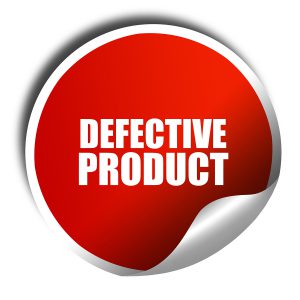Proving Your Defective Product Case
 Michael Babboni
Recalls
No matter the product, defect can lead to serious injury. If a defective product has caused you injury or other damages, you could be looking at a potential claim with compensation you’re entitled to. However, how well do you know what is required by law in order for you to win? Proving your defective product case can be tough, and product companies will often arm themselves well with highly skilled and experienced legal and insurance teams to keep payouts at an absolute minimum.
Michael Babboni
Recalls
No matter the product, defect can lead to serious injury. If a defective product has caused you injury or other damages, you could be looking at a potential claim with compensation you’re entitled to. However, how well do you know what is required by law in order for you to win? Proving your defective product case can be tough, and product companies will often arm themselves well with highly skilled and experienced legal and insurance teams to keep payouts at an absolute minimum.Product liability laws in St. Petersburg, Florida must prove the following in order for you to have a case at all:
• You were injured or a loss was suffered – First and foremost you must prove that you were injured or that a loss was suffered. This loss can be a physical loss to the body or a loss to belongings. For instance, if a pressure cooker malfunctions at home and sends a shard of metal into the window, you may still be entitled to compensation even if you did not suffer an injury to your body.
• The product is defective – To use the previous pressure cooker example, if you were using the product incorrectly when it broke, you will not be entitled to a claim. The product itself must be defective and you must be using the product correctly when the malfunction happens.
• You were using the product as it was intended to be used – If you were using the pressure cooker correctly, but using it to create something other than a meal, you may not be entitled to a claim. You must be using the product as intended when it malfunctions, as well as using it correctly.
Almost Doesn’t Count
Having a product malfunction can be a scary and jarring experience, but it’s important to remember that almost doesn’t count. For example, you have a hand mixer you’re using to make cookies. While using this hand mixer, the mixer suddenly spits out one of the beaters as its spinning inside of the bowl. This beater could have broken something in your kitchen, it could have injured you, but luckily it landed into the thick bed of batter safely.
Because the beater landed in the batter safely without causing loss or injury, you will likely not have a claim. Despite being a scary experience, there are no damages to claim.
Breaking Down Dangerous Design
There are two distinctly different kinds of defective product cases. In most cases, the product was manufactured incorrectly, and these cases are much easier to prove. You might find later that your handheld mixer had a faulty release button, and this is what caused the mixer to release the beater while in motion. However, there are unreasonably dangerous products that have a faulty overall design.
Products with a dangerous design are more difficult to prove, and unless your case is obvious, you may be facing an uphill battle. An easy “open and shut” dangerous design case, for example, would be a craft set that requires a finishing step in the oven, and finding that the pieces are highly flammable. This could cause a fire to catch in the oven, leading to both property damages and injury.
In many cases, products with any sort of dangerous design will have warning labels to alert consumers to potential dangers, thereby limiting the company’s own liability should injuries occur. In other products, the dangerousness of the product may be an essential part of its design. For instance, if a person purchases a new knife set and suffers a bad cut while taking the set out of the box, the product is not unreasonably dangerous but sharp by its own necessary design.
